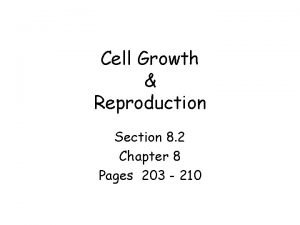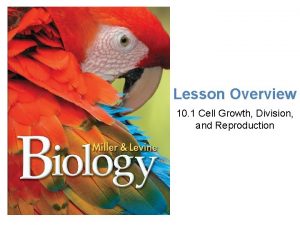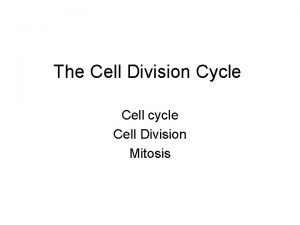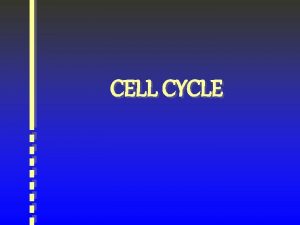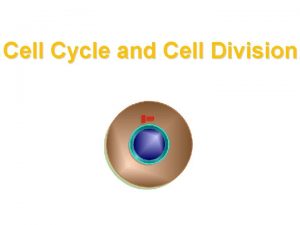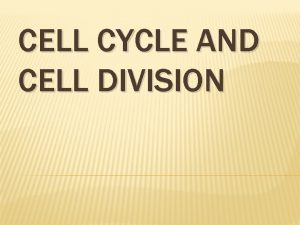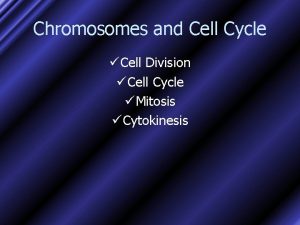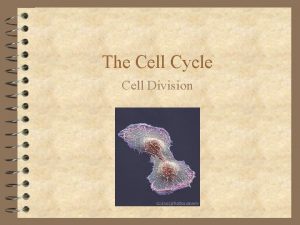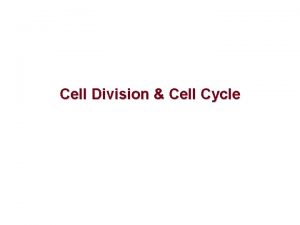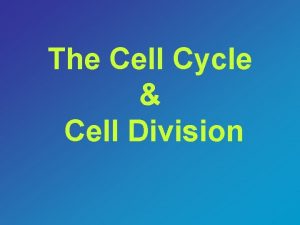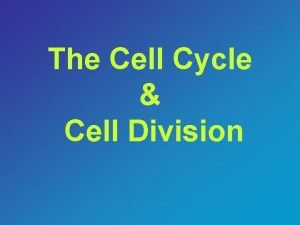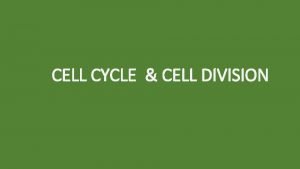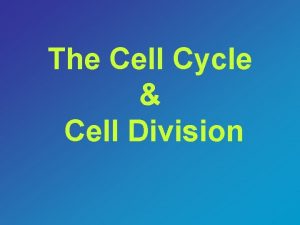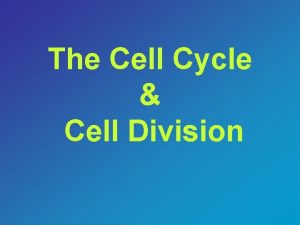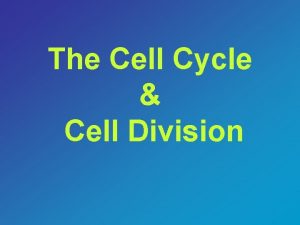The Cell Cycle Cell Growth and Division Growth



















- Slides: 19

The Cell Cycle

Cell Growth and Division Growth- A controlled increase in cell number by cell division [mitosis] Canceruncontrolled cell division – results in a mass of cells called a tumor.

Eukaryotic Cell Division: 1) Mitosis. Nucleus divides into 2 identical nuclei. 2) Cytokinesis. Cytoplasm divides into 2 new cells.

Chromosomes: DNA that is coiled, or “rod-like” during cell division. - the number of these is species specific! Humans- (46) Fruitflies- (8) Crayfish- (144)

Chromosomes

Chromatin In between cell division, chromosomes uncoil and become “threadlike” and invisible.

Sister Chromatids Two parts of a double chromosome joined together by a belt-like centromere.

Stages of Cell Division Cell Cycle – I 1. Interphase 2. Prophase 3. Metaphase 4. Anaphase 5. Telophase then PMAT Stop here and draw the stages in your notebook using the textbook. New book p. 285

Interphase Period in between cell divisions. Genetic material is chromatin, and DNA is replicating.

Prophase First phase of mitosis A. Chromatin thickens (coils) and becomes chromosomes (visible). B. Centrioles (centrosomes) separate and go to opposite sides of the cell (animal cells only) C. Spindle Fibers attach centromere to centriole. D. Nucleolus and nuclear envelope (membrane) disappear.

Prophase

Metaphase Chromosomes line up along the “equator” (center of the cell).

Anaphase Centromeres split Sister chromatids separate and move to opposite poles (move away from each other).

Telophase Chromosomes uncoil and become chromatin Nucleolus and nucleus reappear.

Cytokinesis in Animal Cells After mitosis the cytoplasm divides. Cell membrane pinches in forming a cleavage furrow.

Cytokinesis in Plant Cells A Cell Plate forms between the two nuclei and becomes the new cell walls.

Mitosis Overview Mitosis results in the production of two new genetically identical daughter cells Because of this it is a form of Asexual Reproduction Daughter cells are called Diploid (2 n) because they contain full sets of chromosomes (46 in humans) Mitosis occurs in body cells and results in growth of the organism, or repair of body tissues.

Mitosis makes two exact daughter cells. Identical DNA. Asexual reproduction!!!

 Events of the cell cycle
Events of the cell cycle Cell cycle and cell division
Cell cycle and cell division Steps of cell cycle
Steps of cell cycle Chapter 8 cell growth and division section 8-2 answer key
Chapter 8 cell growth and division section 8-2 answer key Cell growth division and reproduction
Cell growth division and reproduction Long division and short division
Long division and short division Division is a repeated
Division is a repeated What is synthetic division
What is synthetic division Divide using synthetic division
Divide using synthetic division Biology.arizona.edu/cell bio/activities/cell cycle/01.html
Biology.arizona.edu/cell bio/activities/cell cycle/01.html Plant growth definition
Plant growth definition Ground tissue
Ground tissue Primary growth and secondary growth in plants
Primary growth and secondary growth in plants Vascular ray
Vascular ray Mitosis and meiosis
Mitosis and meiosis Parts of chromosome
Parts of chromosome Meiosis
Meiosis Hát kết hợp bộ gõ cơ thể
Hát kết hợp bộ gõ cơ thể Bổ thể
Bổ thể



